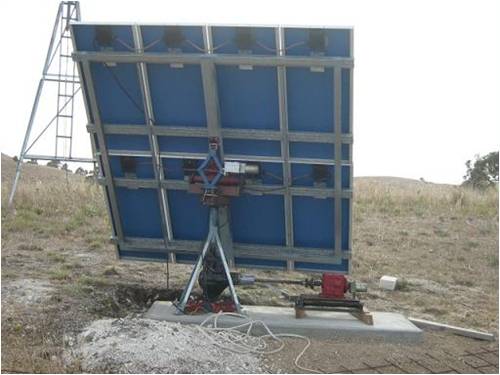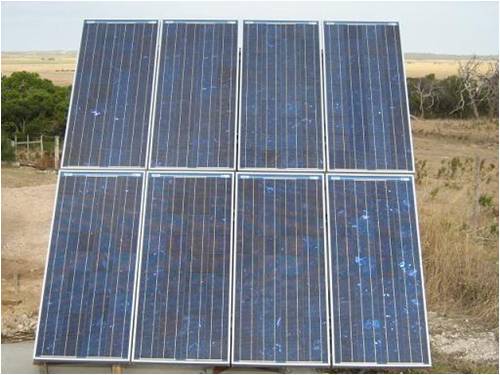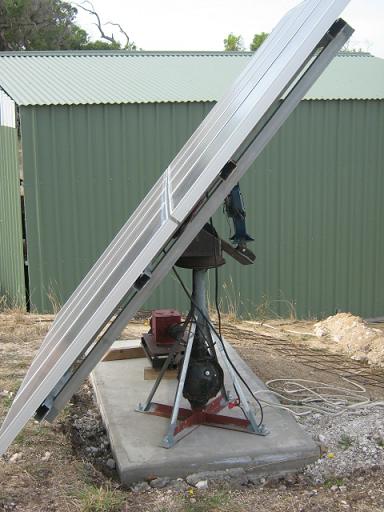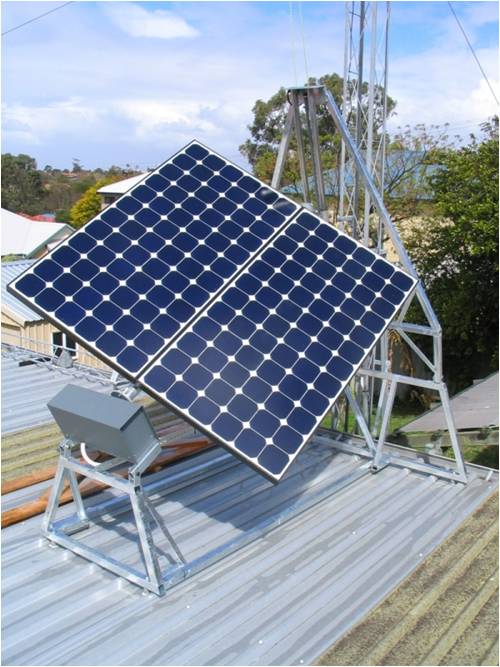
|

|
Forum Index : Solar : Tracking or Extra panels?
| Page 1 of 2 |
|||||
| Author | Message | ||||
| chookie Newbie Joined: 16/03/2009 Location: AustraliaPosts: 18 |
Wondering if anyone can explain how tracking system work? Are they timed to move at set intervals, do they 'sense' where the sun is? How are they powered? And if the installation is on the Mid North Coast at Lat 31 is it cost efficient to look at tracking systems or to add an extra panel to the array? Appreciate answers to any of the above! Smile - be happy - life is too short |
||||
| KarlJ Guru Joined: 19/05/2008 Location: AustraliaPosts: 1178 |
Extra panels, far cheaper. 2 years ago trackers were viable but today panels are cheaper, would get 30% more on a tracker at a cost of at least $1500 (pole, concrete, linear actuators, frame, some simple electronics) today $1500 will get you 300W no problem. By all means have some means of tilting the array for winter and summer, that couldnt be more than a couple of hundred bucks and some time but trackers are more than likely going to need a whole new mounting system, cabling etc etc etc. Luck favours the well prepared |
||||
| KarlJ Guru Joined: 19/05/2008 Location: AustraliaPosts: 1178 |
oh and they work on bright spot in the sky using a pair of Light Dependent resistors or equivalent.. normally powered by either another small panel or independent from the main array. Luck favours the well prepared |
||||
| RossW Guru Joined: 25/02/2006 Location: AustraliaPosts: 495 |
I think it will depend rather a lot on how many panels you have, what your site is like etc. My original array (4 x 80W) was on a fixed frame. I moved it to a sun-tracking (single axis, but with manual adjustment for season) and picked up about 35% more watt-hours per day. I built a traxle with another 4 x 80W panels, but never got around to making the sun-tracking work on it. I did, however adjust it for season. With two identical arrays, cabled to the same battery bank via two identical meters, it was easy (and interesting) to compare outputs of each at different times of day. Tracking certainly makes a difference. Finally, I bought 1200 watts (12 x 100) new monocrystalline earlier this year and built a frame for them. It was completely impractical to put them on any tracking frame I had or could reasonably build myself. The cost of panels by now was so low, I simply added a third to what I'd originally planned (so 800W became 1200W - because I was running them in a 48V configuration, it had to be multiples of 4 panels) This array has withstood 100 kmh wind gusts without batting the proverbial eyelid. If I were to do it again, I'd use a larger cross-section stiffener along the length instead of the 30mm RHS I used here. Possibly a heavier angle iron would be a better bet. It doesn't move much, but I'd rather it didn't move at all. (A second actuator on the other end would fix it too, wire both in series so they move at the same rate). Addendum: I bought another 2KW which arrived just before christmas. I plan to make another similar array for them. Considering mounting them facing north-east so they produce peak output earlier in the day to let my batteries recover sooner and "spread out" my power curve over the day. Or, perhaps half facing northeast and half north-west. Still pondering these. |
||||
Downwind Guru Joined: 09/09/2009 Location: AustraliaPosts: 2333 |
Hi Chookie, As Ross said it all depends on your location and where the panels are mounted. Secondly on how handy you are at building things. If you have to pay someone to build you a tracker than may as do what Karl said and buy extra panels. 2 years ago i built a tracker for a friend who is totally off grid. The increase in power was at least 30% and the power needed to drive it was almost nothing. It travels a 120+/- deg arc and back in the course of the day. The motor was an 24volt dc from an old photo coppier (small) feeding through around a 400:1 gearbox reduction (just happen to be a bit of junk hiding under the bench) The high reduction prevents it being rotated by the wind. This is then coupled to the input of a car diff stood on its end with 1 axle removed and the spider gears welded to make a locker diff. The diff adds another 3.5:1 ratio. The rotation is controlled by time and is moved in steps throughout the day and reversed back to the start each morning at a preset time. We used two time cycles one for winter and one for summer. There was little to gain with fancy time periods throughout the year. We also found that the tilt on the panels made bugger all differance throughout the year and is not adjusted now days (it did have a second motor on it) We considered the use of light sensors tracking the sun but is of little advantage as the sun moves at a constant rate of travel and sensor systems only cause the tracker to hunt on dark days using more power. The more crap you can keep out of the system the more reliable it will be. It is not the prettiest thing i have built but it is robust and has handled some good wind forces without a problem. The only problem has been caused by the owner not fitting the limit switches for an emergency position stop as it had worked so well. A timing glitch soon showed the need for the limit switches. (about a year later) 


Pete. Sometimes it just works |
||||
Downwind Guru Joined: 09/09/2009 Location: AustraliaPosts: 2333 |
Ross, How do you post the photos so you are able to click on them to enlarge the image as you have done above?? ( Hmmm Clever) Pete. Sometimes it just works |
||||
Downwind Guru Joined: 09/09/2009 Location: AustraliaPosts: 2333 |
One thought for an actuator on a panel tracker would be the driveway gate openers. Not that dear off Ebay and are low voltage operation. Almost made for the job. A range of sizes and operating strengths avaliable. Nice work Ross, once i figured out to enlarge the photos and get the eyelash marks off the screen from trying to peer at the small pics. (Doh!) Pete. Sometimes it just works |
||||
| RossW Guru Joined: 25/02/2006 Location: AustraliaPosts: 495 |
Well, I usually just post an html link - but this forum refuses to take my "plain html", so I have to work within it's obscure tag construct. Basically, I host my own images, and there are thumbnails for each already there, so I create a "link" to the full size image (the litle chain icon beside the Underline in your compose/post window). Then, for the text that the link will have, I use the image source (the picture of the tree (without the arrow). It's actually pretty trivial - it's be nicer if the forum software let the images as tags actually show that they're a link - but you figured it out anyway! (I usually do this, it lets people only grab the thumbnail if they're not interested, but look at the full image if they want to) Oh, the actuators I used are for satellite dish positioners - they're relatively cheap, run on anything from 12 to 36 volts, are strong, designed for outdoor use, have all the hardware you need to mount them etc. Also available on ebay as well as any number of normal stockists. |
||||
| Jarbar Senior Member Joined: 03/02/2008 Location: AustraliaPosts: 224 |
Tracking the sun,a what if question. On a static roof mounted PV system would any advantage come from mounting a row of convex mirrors at the top of the panels. If they were cut horizontally in half would the reflected light if focused correctly add any extra power when the sun is rising and setting. This would be easier than rotating the panels. "Creativity is detirmined by the way you hold your tounge".My Father "Your generation will have to correct the problems made by mine".My Grandfather. |
||||
| KarlJ Guru Joined: 19/05/2008 Location: AustraliaPosts: 1178 |
yep that been done too. The one I saw was called and STS-4 concentrator and they had roof concentrators as wellconcentrator and thisconcentrator Luck favours the well prepared |
||||
| chookie Newbie Joined: 16/03/2009 Location: AustraliaPosts: 18 |
Hi and thankyou so much to everyone for contributing to my education! In murky waters this site provides practical, first hand experiences! Re the tracking systems - yes we have the capabilities and the technology (hubbie engineering background and a shedload of toys) to build a system ourselves but are limited by the fact that the govt grant/energy supplier conditions are that we have to have an accredited installer. How do you go about upgrading a grid connect system at a later date DIY? Smile - be happy - life is too short |
||||
Downwind Guru Joined: 09/09/2009 Location: AustraliaPosts: 2333 |
With the refferance to hubbie i hope i have not used any colourful expressions in my postings. (whoops?) I am guessing but would a accredited installer really care where he had to fix the pannels to, if the system is in place and the extra cable was run for him already. Sounds like a dream installation with no clamering around on someones roof. The biggest issue with tracking is the shading problem. This creates a bigger ground foot print required, so one pannel dont cast a shaddow over the next. For this reason i choose to to have one flat pannel and just follow the arc of the sun and creating a smaller footprint. You must remember you are creating a big sail and is subject to some high wind loadings. Our intensions were to monitor the wind and if it got above a given speed to turn the pannels side on. This has not been done as the diff arrangement has handled all situations thus far easily. My thoughts are if you can keep that spot in the sky pointed at the pannels you cant get any better. Now if we could move the sun to suit?? Pete. Sometimes it just works |
||||
| KarlJ Guru Joined: 19/05/2008 Location: AustraliaPosts: 1178 |
I too still like the tracker arrangement but it has to be cheap or panels win on a cost basis. The roof concentrator (which I couldnt find) seemed like a great idea, 1.3sun concentration which worked in winter, not so much in summer and no moving parts. If you look you will find it. Again problem is that stainless sheet is expensive and second hand mirrors dont last very long in the weather. Luck favours the well prepared |
||||
| Tinker Guru Joined: 07/11/2007 Location: AustraliaPosts: 1904 |
Pete, a question on your ingenious diff based tracker. It appears to track the sun with the inclined panels rotating on a vertical axis. I am wondering if this way is more or less efficient than having the panels rotate on an inclined axis (N,S orientated)? 
The picture shows my tracker which is two axis tracking. The second axis is not really difficult to incorporate, I think it does make a difference for those living further N or S of the tropics. Klaus |
||||
Downwind Guru Joined: 09/09/2009 Location: AustraliaPosts: 2333 |
There is a car jack stuck up the rear of the mount that had a geared motor on it for tilt. The whole lot pivots off the main centre beam and can be tilted forwards and backwards as well as rotated. The owner choose not to use the tilt from trials done made little difference to their requirements and just another thing to cause a problem. I do agree with your method and its well engineered. The one i built was thrown together in a week over the Xmas break a few years back in pieces, so it could be easily transported 400km and errected. It was to be strong and be better than what was in use at the time. (panels on a fixed frame in padock) One of the best ways to get some idea is to play with a mirror at various times of the day, with the objective to direct the light straight back to its source and note the mirror angles required to do it. One soon gets a mental image that any tracking is better than none. I did read your thread some time back but how are you controlling your system.? (could be a good picaxe project  ) )
Pete. Pete. Sometimes it just works |
||||
| Tinker Guru Joined: 07/11/2007 Location: AustraliaPosts: 1904 |
Pete, the control for this tracker could not be simpler, its all electro mechanical. The heart is a domestic digital plug in timer (7 day/ 14 event) which I modified to run of the 24V battery since it then uses about 50 times less running power. This timer sends 1min long 12V power pulses at preset times up to the motor controller. Once the motor starts turning a cam operated microswitch determines for how long it rotates (15 degrees) and then stops. The panel starts facing 45 deg east from 6AM and advances by 15 deg at 9:30, 10:30, 11:30, 12:30, 13:30 & 14:30. At 6PM it returns to horizontal in 1 min intervals and stays that way until 6AM. Each time the solar panels move the elevating all-thread turns 90 degrees. This adds to 3 full revolutions (12X 90 deg) per 24 hours, which corresponds to the angle of daily change of the sun's elevation on this tracker frame. The beauty of this system is that there is NO tracker power drawn until the 12V motors actually move - which is only for seconds. I calculated the yearly drive power consumption at about 1Ah from a 12V battery. So, no, I won't be converting it to picaxe programmed tracking but I would like to log the output over a full day from time to time. Klaus |
||||
Loomberah Regular Member Joined: 11/06/2008 Location: AustraliaPosts: 43 |
For a larger number of panels, within reason, its less expensive to build a tracker than buy more panels My trackers Rear one is a single axis Solenergy unit bought over ebay, larger one I built myself, its a proper equatorial mount along the lines of those I build for telescopes. Despite having twice the panels (and another 2 added since that time-lapse was made) it is much more stable in strong winds than the commercial unit. I use 2 linear actuators to drive it and the tracking is provided by a sensor unit from Dave Harvey in Cowra It parks horizontally overnight or during strong winds, to reduce wind loading. Solar tracking sensors Gordon Loomberah weather +solar&UV, astronomy, photography, organic farm |
||||
| neil0mac Senior Member Joined: 26/12/2009 Location: AustraliaPosts: 210 |
Chookie, With all due respects to all of those who have replied, you need to get more answers before deciding. Those from 'further south', (or northeners) have a different view of things? FYI , you (31 deg) and 'Loomberah' (31.15) and I (30.50) are very nearly all on exactly the same latitude - just going a little further west each time though! (And, at a guess, we can't be further than 260 Km apart, in a straight line - unless you're on a boat out to sea, or west or the 150th meridian!) |
||||
| VK4AYQ Guru Joined: 02/12/2009 Location: AustraliaPosts: 2539 |
Hi All I made a very simple tracker with very little hi tech gear it was a 20 ft square patform for the panels double cross braced to avoid twisting andd damageing the panels, it was pivoted off center so it was returning to start position by gravity, pivot 80 deg total. The actuator was a water ram with an adjustable inlet orifice made from a needle type fuel tap to adjust the inlet into the water ram so it made the 80 deg over 8 hours. a water dump control was a 3/8" solinoid valve with hold close power on through a LDR control board from Jaycar but could be run from solar panel output to simplify, would need a diode in line to prevent back feed fron the battery good idea anyway. I had to fit a small domestic type filter to the water line to avoid clogging the inlet metering valve. On the tracking accuracy, it made no difference if it was 5 or so degrees of true so high tech trackers where not nessesary. The array was set half way between summer and winter settings with no real difference on overall output, still returned 30+% increase. The unit was fitted with gas shocks from a 4WD to damp out vibration from the wind and aid returm to morning position. Limit stops where just solid rubber blocks to absorb stoping bumps being transferred to the panels. Ram was made from Alm irrigation pipe but could be thick poly pipe 6" dia with a teflon piston anf a SS rod very simple construction, water pump about 35 psi from memory, did work one from overhead tank at about 20 psi. Water returns to tank if required or waters garden. I found that smaller trackers not cost effective on a 30% return on extra power as it cost nearly6 the same to make a small one as a bigger one. Moral of the story if you have got 6/8 panels buy two more its easier unless you can do all the work yourself. This array was used with 20+ panels then the effort is worth it. All the best Bob Foolin Around |
||||
| Tinker Guru Joined: 07/11/2007 Location: AustraliaPosts: 1904 |
Yes Bob, but does one include cost in the process of enjoying tinkering out a working tracker for the first time? In my case it was well worth the challenge and it turned out not expensive either, using mostly scrounged parts that were stored in the shed for years  .. ..
Bigger trackers require more solar panels and that is where the real expense is, IMO anyway. Klaus |
||||
| Page 1 of 2 |
|||||